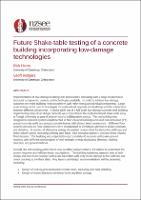| dc.description.abstract | Implementation of low-damage buildings has been rapidly increasing with a range of alternative structural components, devices, and technologies available. In order to achieve low-damage outcomes the entire building needs to perform well rather than just individual components. Large-scale testing can be used to investigate the system level response of a buildings and the interactions between different components. A shake-table test of a full-scale low-damage concrete wall building implementing state-of-art design concepts was conducted on the multi-functional shake-table array at Tongji University as part of an international collaborative project. The test building was designed to represent systems implemented in New Zealand buildings and used post-tensioned (PT) precast concrete walls and precast concrete frames with slotted beam connections. Different floor systems and wall-to-floor connections were incorporated to investigate alternative design concepts and detailing. A number of alternative energy dissipation devices were located at the wall base and beam-column joints, including yielding steel fuses, lead-extrusion dampers, and non-linear viscous fluid dampers. The building was subjected to approximately 40 separate earthquake ground motions, with different combinations of wall strength, energy dissipating elements, shaking direction, and ground motions. Overall, the test building performance was excellent and provided a rich dataset to understand the system response and validate design assumptions. The building sustaining repeated tests at both design and maximum consider earthquake intensities with only minor damage to the wall toes and minor cracking to the floor slabs. Key lessons and design recommendations will be presented, including: • Design of rocking post-tensioned concrete walls, including wall base detailing. • Design of slotted beams to minimise frame and floor damage.
NZSEE 2021 Annual Conference
• Design of wall-to-floor connections and implications of different design approaches. • Building overstrength and effect of component interactions. • Validation of direct displacement-based design methods. • Implication of torsional response on post-tensioned wall buildings. • Repairability of both primary structural systems as well as secondary components and connections. • Development and testing of different energy dissipating devices. • Design considerations and equivalence of different energy dissipating devices with varying response characteristics. | |

